
We recommend you visit the interactive version. The text to the right is provided for printing purposes.
|
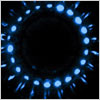

|
|
If
you are ever lucky enough to dive deep into the ocean in a submersible, be sure
to turn out the lights. You will be treated to one of the greatest natural
light shows on the planet—explosions of blue sparks, puffs of liquid-blue
smoke, and dancing electric-blue racing stripes that swirl and stretch into
nothingness. All this light is bioluminescence—visible light made by
living creatures. Rare on land, bioluminescent organisms are common in the
oceans, particularly in the upper 3,000 feet. This is a world without hiding
places, where sunlight filtering down through the depths decreases until all
visible light disappears around that 3,000-foot level. In this twilit realm, the
light is dim and blue and highly directional, so the only animals visible are
either directly overhead or producing their own light. In this slide show, meet
some of the bizarre creatures that create bioluminescence and learn how they
use it to survive in the oceans.
Edie Widder, an expert in bioluminescence, is a biologist and deep-sea explorer.
|
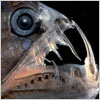

|
|
Invitation
to a meal
Bioluminescence can serve as a lure to attract prey. The
viperfish, Chauliodus sloani, has a luminescent lure on the end of a modified fin ray that it
can arch forward in front of its mouth. In the dim depths, all that the viperfish's
would-be prey sees is a glowing morsel. When this prey comes in close, the
viperfish quickly impales it with its enormous, viper-like fangs. These fangs
are so long that if they were fully inside its mouth, the fish would impale its
own brain.
|
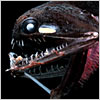

|
|
Mating
games
The cheek lights on the deep-sea loosejaw
fish may serve to locate prey in the dark, but they likely also function in
mate selection, since the organs of males are much larger than those of
females. When not in use, these lights can be rotated and pulled back into the
fish's head, sort of like the headlights on some cars. They also can be
flashed on and off. So why retract them? Probably because they have a highly
reflective layer that helps direct light outward. This shiny surface, in
contrast to the fish's velvety black body, might inadvertently reveal the
animal's whereabouts to predator or prey.
|
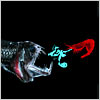

|
|
Puzzling predators
Some animals, such as the deep-sea shrimp, Acanthephyra purpurea, use their bioluminescence to distract or blind predators. The shrimp can actually vomit light into the face of its attacker and then back flip away into the darkness. In this image, which is a composite of flash photos of the animals and a still video frame of the luminescence, a deep-sea shrimp temporarily blinds a viperfish, Chauliodus danae.
|
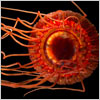

|
|
Burglar alarms
Other animals use their bioluminescence
to "scream" for help. Once an animal is caught in the clutches of a
predator, its only hope for escape may be to attract the attention of something
bigger and nastier that may attack and eat whatever is about to eat it. This amazing
light show is known as a "burglar alarm" display. The deep-sea jellyfish,
Atolla wyvillei, is a
master of this display.
|
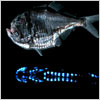

|
|
A clever disguise
Bioluminescence can provide effective
camouflage. In the twilit depths, the silhouette of an animal against the
sunlight filtering down is an easy target. This is why many open-ocean
predators like the hatchetfish have upturned eyes and mouths. But the hatchetfish itself is prey to bigger fish swimming
below it. It's narrow silhouette and silver sides make it harder to see,
but it also emits light from its belly that is a perfect match in color and
intensity to sunlight filtering down. If a cloud dims the sunlight, the fish
dims its bioluminescence—a trick called counterillumination.
|
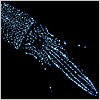

|
|
Everybody's doing it
Counterillumination is something you need to see to believe. One testament to its effectiveness is the enormous numbers of animals that use it. They include the benttooth bristlemouth (which, notably, is the most common vertebrate on the planet), lantern fish, viperfish, scaly dragonfish, krill, and squid. The squid in this image, Abralia veranyi, is such a master of disguise that it can change the color of its belly lights depending on whether it is counterilluminating against sunlight or moonlight.
|
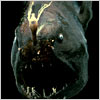

|
|
A little help from little friends
While most bioluminescent animals
synthesize their own light-producing chemicals, a few
animals have developed symbiotic relationships with bioluminescent bacteria. One
example is the anglerfish (pictured here), which uses a luminescent lure packed
with glowing bacteria. Another case is the flashlight fish. It has a large
light organ under each eye, where such bacteria grow in a nutrient-rich
environment that the fish provides. The fish can effectively
"flash" its lights by sliding flaps of skin over these light
organs, momentarily blocking the bacterial light.
|
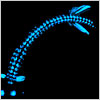

|
|
All lit up
Many animals rely on bioluminescence for more than one purpose. This blackdragon fish (Melanostomias bartonbeani), for example, has a flashlight next to each eye that it can "turn on" to look for prey or signal mates. It has a chin barbel that it can use as a lure. It has light organs arrayed along its belly that will hide its silhouette. And it has luminous bodies embedded in the gelatinous dermis and between the fin rays that serve it well during a burglar alarm display. As for so many creatures in the ocean, bioluminescence no doubt serves it well.

|
|
|




